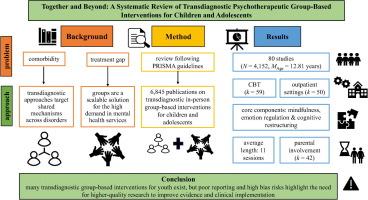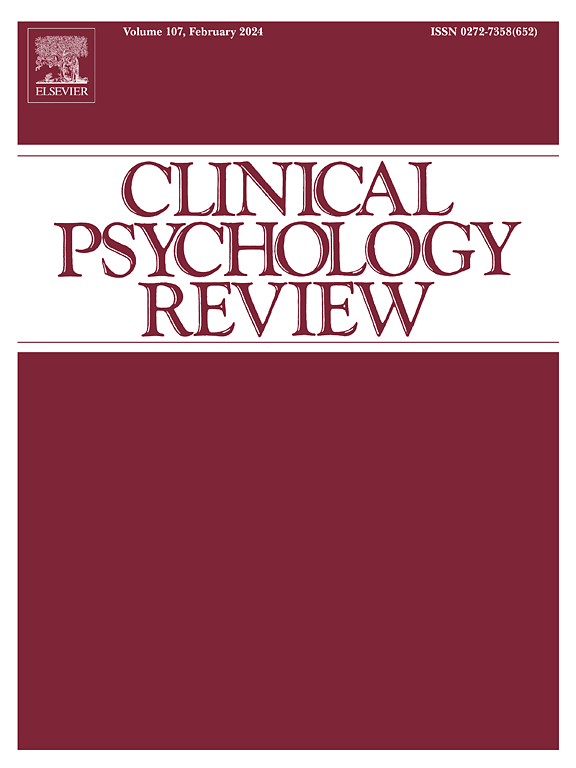共同和超越:对儿童和青少年跨诊断心理治疗群体干预的特征和疗效的系统回顾
IF 12.2
1区 心理学
Q1 PSYCHOLOGY, CLINICAL
引用次数: 0
摘要
跨诊断团体干预措施解决了青年心理保健服务的局限性,包括现有治疗方法的特定障碍性质和个人心理治疗的有限能力。本文综述了儿童和青少年跨诊断群体干预的特点、应用、家长参与、患者和公众参与(PPI),以及儿童和青少年跨诊断群体干预的有效性、依从性、安全性和治疗满意度证据。遵循PRISMA指南,预先注册的系统文献检索确定了6845份关于儿童和青少年(平均年龄≤18岁)跨诊断面对面群体干预措施的出版物。两位审稿人使用rob2和ROBINS-I工具独立筛选纳入、提取数据并评估偏倚风险。该综述检查了80项研究,包括4152名参与者(年龄为12.81岁),主要在高收入国家进行。认知行为疗法是最常用的方法(κ = 59),其核心成分是正念、情绪调节和认知重组。干预平均为11次,52%涉及父母。22项研究针对焦虑和抑郁的联合,并有积极的前后效应。其他疾病的症状严重程度也有显著降低的报道,尽管结果测量差异很大,与积极对照条件或常规治疗的组比较通常不显著。很少有研究检查非特异性疾病的结果,如心理社会功能、生活质量,或报告的缓解率、治疗满意度或应用PPI框架。虽然已经开发和评估了大量不同的青年跨诊断群体干预措施,但缺乏严格的报告和高偏倚风险突出表明需要进行更高质量的研究,以加强证据和改善临床实施。本文章由计算机程序翻译,如有差异,请以英文原文为准。

Together and beyond: A systematic review on characteristics and efficacy of transdiagnostic psychotherapeutic group-based interventions for children and adolescents
Transdiagnostic group interventions address the limitations of youth mental health care services, including the disorder-specific nature of existing treatments and the limited capacity of individual psychotherapies. This review synthesizes the 1) characteristics, applications, parental involvement, patient and public involvement (PPI), and 2) data on efficacy, adherence, safety and treatment satisfaction evidence of transdiagnostic group interventions for children and adolescents. Following PRISMA guidelines, a preregistered systematic literature search identified 6845 publications on transdiagnostic in-person group-based interventions for children and adolescents (mean age ≤ 18 years). Two reviewers independently screened for inclusion, extracted data, and assessed risk of bias using the RoB-2 and ROBINS-I tool. The review examined 80 studies encompassing 4152 participants (Mage = 12.81 years), mostly conducted in high-income countries. Cognitive behavioural therapy was the most commonly used approach (κ = 59), with the core components mindfulness, emotion regulation, and cognitive restructuring. Interventions averaged 11 sessions and 52 % involved parents. 22 studies targeted anxiety and depression jointly with positive pre-post effects. Significant reductions in symptom severity were also reported for other disorders, though outcome measures highly varied and group comparisons with active control conditions or treatment-as-usual were often non-significant. Few studies examined disorder-unspecific outcomes like psychosocial functioning, quality of life, or reported remission rates, treatment satisfaction or applied a PPI framework. While a large number of different transdiagnostic group interventions for youth have been developed and evaluated, the lack of rigorous reporting and high risk of bias highlight the need for better-quality research to strengthen evidence and improve clinical implementation.
求助全文
通过发布文献求助,成功后即可免费获取论文全文。
去求助
来源期刊

Clinical Psychology Review
PSYCHOLOGY, CLINICAL-
CiteScore
23.10
自引率
1.60%
发文量
65
期刊介绍:
Clinical Psychology Review serves as a platform for substantial reviews addressing pertinent topics in clinical psychology. Encompassing a spectrum of issues, from psychopathology to behavior therapy, cognition to cognitive therapies, behavioral medicine to community mental health, assessment, and child development, the journal seeks cutting-edge papers that significantly contribute to advancing the science and/or practice of clinical psychology.
While maintaining a primary focus on topics directly related to clinical psychology, the journal occasionally features reviews on psychophysiology, learning therapy, experimental psychopathology, and social psychology, provided they demonstrate a clear connection to research or practice in clinical psychology. Integrative literature reviews and summaries of innovative ongoing clinical research programs find a place within its pages. However, reports on individual research studies and theoretical treatises or clinical guides lacking an empirical base are deemed inappropriate for publication.
 求助内容:
求助内容: 应助结果提醒方式:
应助结果提醒方式:


